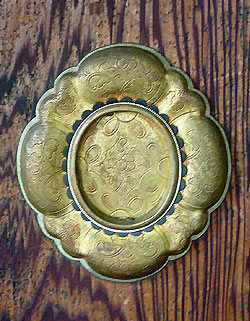|
||
 |
||

Kawagoejou
Honmaru 川越城本丸 (Saitama)
(C)2001 Japanese Architecture and Art Net Users System. No reproduction or republication without written permission.
掲載のテキスト・写真・イラストなど、全てのコンテンツの無断複製・転載を禁じます。
|
||||||
| hikite 引手 | ||||||
| KEY WORD : architecture / accessoiries | ||||||
| Lit. hand pull. Commonly called door pull. A
door pull added to sliding doors *fusuma
襖, or hinged doors to help open and close them with a pulling motion. Wood door
pulls mokusei 木製 were common in ancient periods but in general door pulls
were made of metal and called hikite kanagu 引手金具. Door pulls, especially
in the shoin style *shoin-zukuri
書院造, particularly from the late 15c on, began to have a wide variety of designs,
some of which were also used for nail covers *kugikakushi
釘隠. The most elaborate door pulls were found on fusuma and cedar doors
at Katsura Rikyuu Shingoten 桂離宮新御殿 (mid-17c), and Daigoji Sanbouin,
醍醐寺三宝院 (end 16c), both in Kyoto. Door pulls were also used on the *choudaigamae
帳台構え, doors concealing guardsmen. These doors had elaborate tassels and were called *fusahikite 総引手 or tasseled pulls. Door pull designs include: the character
moon, tsuki 月; a design based on the shape of a woman's hat, ichimegasa
市女笠; matsuba 松葉 (pine needles); musubihimo 結紐 (stylized flowers),
and buds to name a few. The term hikite is also used for drawer handles,
and the handles used to open boxes. There are also handles with rings attached
to pull open doors. |
||||||
 Kawagoejou
Honmaru 川越城本丸 (Saitama)
|
||||||
| REFERENCES: | ||||||
| EXTERNAL LINKS: | ||||||
| NOTES: | ||||||
(C)2001 Japanese Architecture and Art Net Users System. No reproduction or republication without written permission. 掲載のテキスト・写真・イラストなど、全てのコンテンツの無断複製・転載を禁じます。 |
||||||